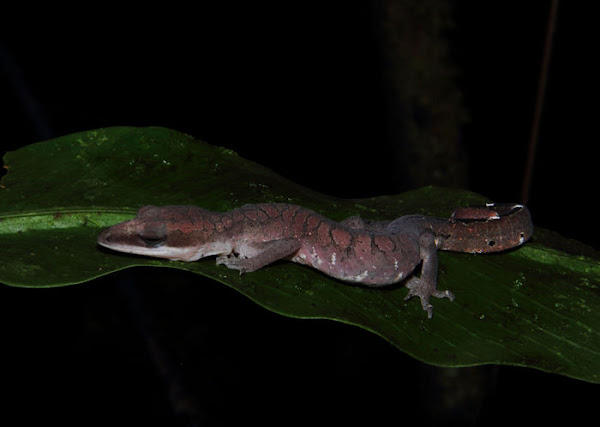Aeluroscalabotes felinus (Cat Gecko)
The common name of this Gecko Lizard in English is commonly called Cat Gecko and Thai name called ตุ๊กแกป่าหัวโต (Tukgae-Pa-Hua-Toh).
ตุ๊กแกป่าหัวโต : Aeluroscalabotes felinus (Günther, 1864)
Aeluroscalabotes felinus is a species of the Cat Gecko Lizard Genus (Aeluroscalabotes) within the Eyelid Gecko Family (Eublepharidae), Superfamily Gekkota, in the Lizard and Snake Order (Squamata), in the Reptile Class (Reptilia), in the Chordate Phylum (Chordata) in the Animal Kingdom (Animalia).
Published in Günther, A. The Reptiles of British India. London (Taylor & Francis), xxvii + 452 pp. (1864).
Subspecies
- Aeluroscalabotes felinus felinus
- Aeluroscalabotes felinus multituberculatus Kopstein, 1927.
Geographic Range
This species distribution range extends from southern Thailand, where it is known only from the extreme south of the country in provinces bordering Malaysia (N. Panitvong pers. comm. 2017), southward through Peninsular Malaysia and Singapore, and it is also known from Borneo.
Aeluroscalabotes felinus is associated with the mountain systems Ulu Muda, Kedah (Nosham et al. 2005) and Temengor, Perak (Grismer et al. 2004) in the north, southward through the Banajan Bintang to Bukit Larut, Titiwangsa to Templer´s Park, Selangor, and Pasoh, Negeri Sembilan (Chan et al. 2009).
Subpopulations have also been reported from Enau-Rompin, Johor (Wood et al. 2008) and Singapore (Sworder 1925, Grismer 2011). In South Thailand, it has been recorded from Betong Patani (The Field Museum 2017).
In Borneo, it has been recorded in Gunung Mulu, Lundu, Kapit District (Sarawak) Lahad Datu, Tawau District and Sandakan (Sabah) (The Field Museum 2017) and Central Kalimantan (D. Iskandar pers. comm. 2017).
Habitat and Ecology
This cryptic, arboreal, nocturnal species has been found in both lowland and hill dipterocarp forest. It is a species difficult to find because of its tendency to remain motionless when in potential danger.
It is most commonly found one to three metres above the ground in brushy vegetation or small trees in the vicinity of water (Grismer et al. 2004, Norhsam et al. 2005, Wood et al. 2008). Although it can be found throughout the year, it is most common during September and October.
Gravid females have been found during March and August, and hatchlings during September (Grismer 2011). It ranges from sea level up to 600 m asl (L. Grismer, J. McGuire and D. Iskandar pers. comm. 2017).
Synonym
- Pentadactylus felinus Albert Charles Lewis Günther (1864)
- Pentadactylus borneensis Albert Charles Lewis Günther (1864)
- Pentadactylus dorsalis Wilhelm Karl Hartwich Peters (1871)
- Aelurosaurus felinus George Albert Boulenger (1885)
- Aelurosaurus dorsalis George Albert Boulenger (1885)
- Aeluroscalabotes felinus George Albert Boulenger (1885)
- Aeluroscalabotes felinus George Albert Boulenger (1887)
- Aeluroscalabotes dorsalis George Albert Boulenger (1887)
- Aeluroscalabotes felinus Nelly de Rooij (1915)
- Aeluroscalabotes dorsalis Nelly de Rooij (1915)
- Aeluroscalabotes longicaudatus Lars Gabriel Andersson (1923)
- Aeluroscalabotes felinus multituberculatus Felix Kopstein (1927)
- Aeluroscalabotes felinus Edward Harrison Taylor (1963)
- Aeluroscalabotes felinus Herbert Rösler (1995)
- Aeluroscalabotes felinus Ulrich Manthey & Wolfgang Grossmann (1997)
- Aeluroscalabotes felinus Merel J. Cox et al. (1998)
- Aeluroscalabotes multituberculatus Djoko Tjahjono Iskandar & Mumpuni (2002)
- Aeluroscalabotes felinus Hermann Seufer et al. (2005)
